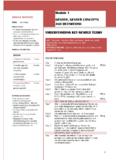Transcription of Questions about culture, gender equality and …
1 Questions about culture , gender equality and development cooperation Why this note? Concerns about culture are frequently raised in relation to initiatives for gender equality in development cooperation. In some cases, program officers or partners are concerned that promotion of gender equality would interfere with local culture , and therefore feel that gender equality should not be promoted for ethical reasons. In other cases, the cultural values of a particular area are described as a major constraint on efforts for gender equality , and therefore action is considered to be difficult for practical reasons. Are these concerns valid?
2 What should we be doing as development workers? What do we mean When we talk about culture we often mean intellectual and creative products, by culture ? including literature, music, drama, and painting. Another use of culture is to describe the beliefs and practices of another society, particularly where these are seen as closely linked with tradition or religion. But culture is more than that. culture is part of the fabric of every society, including our own. It shapes the way things are done and our understanding of why this should be so. This more comprehensive approach is proposed in the definition of culture adopted at the World Conference on Cultural Policies (Mexico, 1982) and used in ongoing discussions on culture and development : culture is the whole complex of distinctive spiritual, material, intellectual and emotional features that characterize a society or a social group.
3 It includes not only arts and letters, but also modes of life, the fundamental rights of the human being, value systems, traditions and beliefs. 1. How is gender Expectations about attributes and behaviours appropriate to women or men and related to about the relations between women and men in other words, gender are culture ? shaped by culture . gender identities and gender relations are critical aspects of culture because they shape the way daily life is lived in the family, but also in the wider community and the workplace. gender (like race or ethnicity) functions as an organizing principle for society because of the cultural meanings given to being male or female.
4 This is evident in the division of labour according to gender . In most societies there are clear patterns of women's work and men's work, both in the household and in the wider community and cultural explanations of why this should be so. The patterns and the explanations differ among societies and change over time. While the specific nature of gender relations varies among societies, the general pattern is that women have less personal autonomy, fewer resources at their disposal, and limited influence over the decision-making processes that shape their societies and their own lives. This pattern of disparity based on gender is both a human rights and a development issue.
5 Are cultures and Societies and cultures are not static. They are living entities that are continually traditions being renewed and reshaped. As with culture more generally, gender definitions unchanging? change over time. Change is shaped by many factors. Cultural change occurs as communities and households respond to social and economic shifts associated with globalization, new technologies, environmental pressures, armed conflict, development projects, etc. For example, in Bangladesh, changes in trade policies allowed for the growth of the garment industry, which drew large numbers of women into the urban labour force.
6 This process has involved a reinterpretation of the norms of purdah (female seclusion) by the women CIDA: Questions about culture , gender equality and development cooperation /1. entering this employment and by their families. The much greater visibility of women in cities such as Dhaka is also influencing public perceptions of possible female roles in the family and the Change also results from deliberate efforts to influence values through changes in the law or government policy, often due to pressure from civil society. There are many examples of efforts to influence attitudes about race relations, the rights of workers and the use of the environment, to name three areas in which cultural values shape behavior.
7 Efforts to reshape values about women and gender relations have focused on concerns such as the number of girls sent to school, women's access to paid work, and public attitudes to domestic violence. New cultural definitions are formed through a process in which some segments of society promote change through advocacy and example, while others resist it. In other words, societies are not homogeneous and no assumptions can be made about a consensus on cultural values.. If it is As suggested in the point above, cultural values are continually being reinterpreted cultural in response to new needs and conditions. Some values are reaffirmed in this is it process, while others are challenged as no longer appropriate.
8 Unquestioned? A member of the Cambodian government uses a vivid image when describing the need to question the cultural norms that reinforce gender inequality. She says the aim is not to overturn the cultural identity of the nation, but to focus on the elements within it that oppress women: There is a Cambodian saying that men are a piece of gold, and women are a piece of cloth. The piece of gold, when it is dropped in mud, is still a piece of gold. But a piece of cloth, once it's stained, it's stained forever. If you are a prostitute, if you have been raped, it you are a widow, you are no longer that virginal piece of cloth.
9 But men, whether they are criminal or have cheated on their wives, they are still a piece of gold. When there is such a saying, a perception, then there is something wrong with that culture and that's when you want to change it. 3. Are there We noted that gender identities and gender relations are critical aspects of culture different interests because they shape daily life. Changes in gender relations are often highly that we should be contested, in part because they have immediate implications for everyone, women aware of? and men. This immediacy also means that gender roles and particularly women's roles as wives and mothers can be potent symbols of cultural change or cultural continuity.
10 The political potential of such symbols is evident in the ways that religious and political movements have focused on women's roles. This has served to highlight adherence to religious or cultural values and resistance to western influences. In such contexts, internal efforts for change become even more complex as those advocating change can easily be dismissed as unpatriotic, irreligious, or tainted by the west. However, religious beliefs and national identity are also important to women. This is evident in the efforts by different groups of women to review interpretations of religious texts and to reaffirm values and traditions that support freedom and dignity for This example reinforces two points made earlier: that cultural values are constantly evolving rather than fixed and that there are different interests intervening in the process.

















